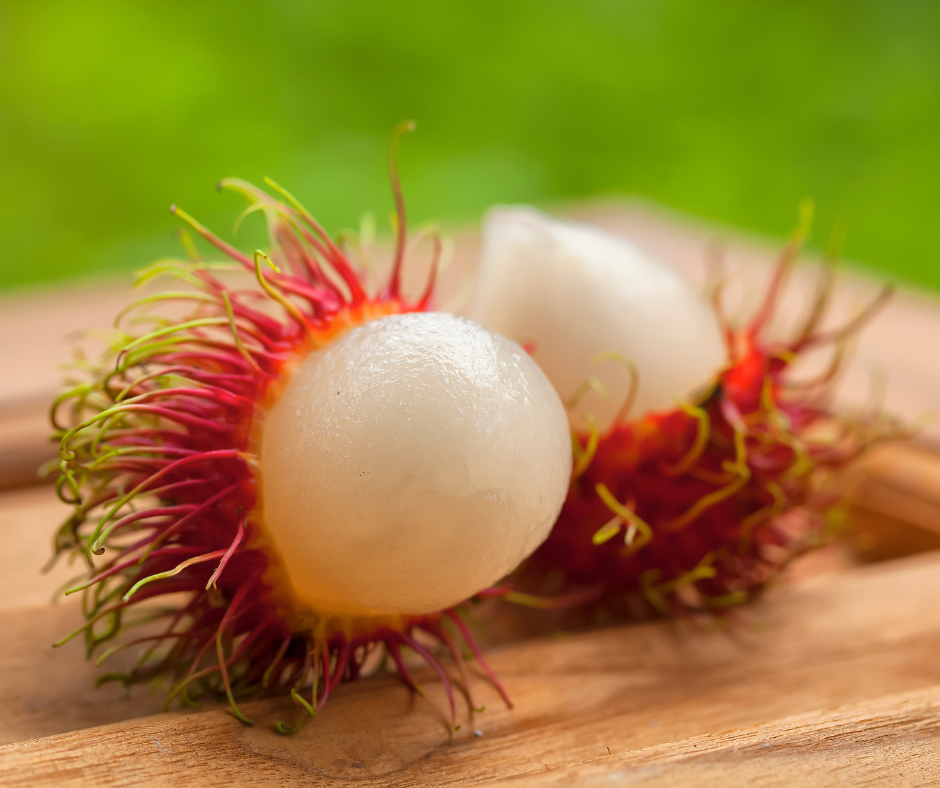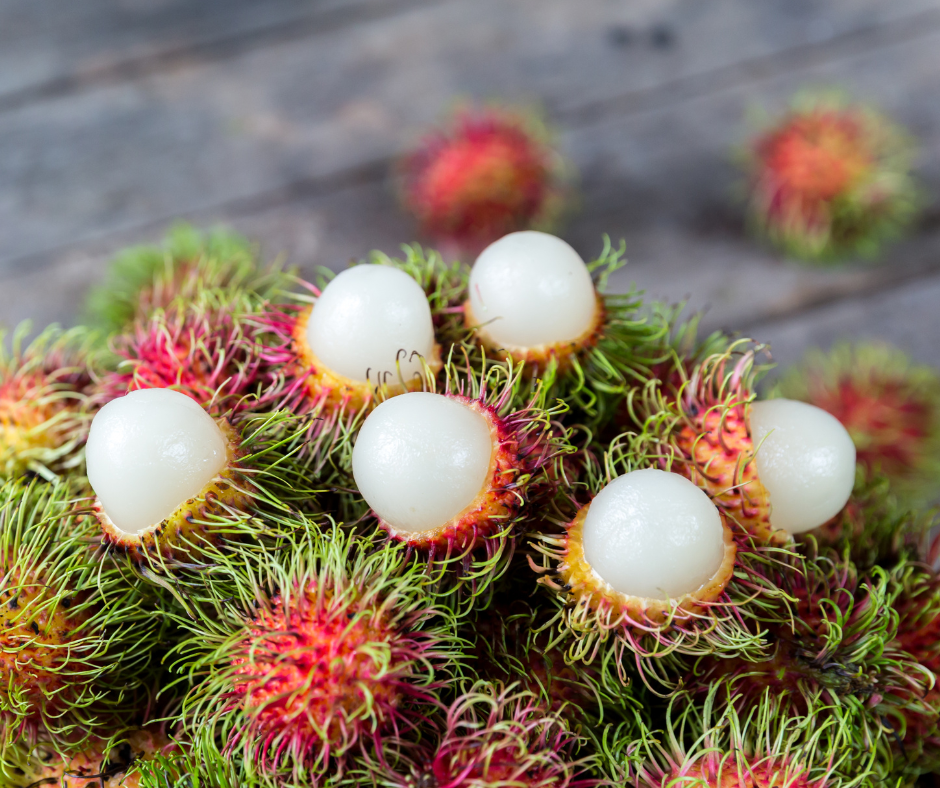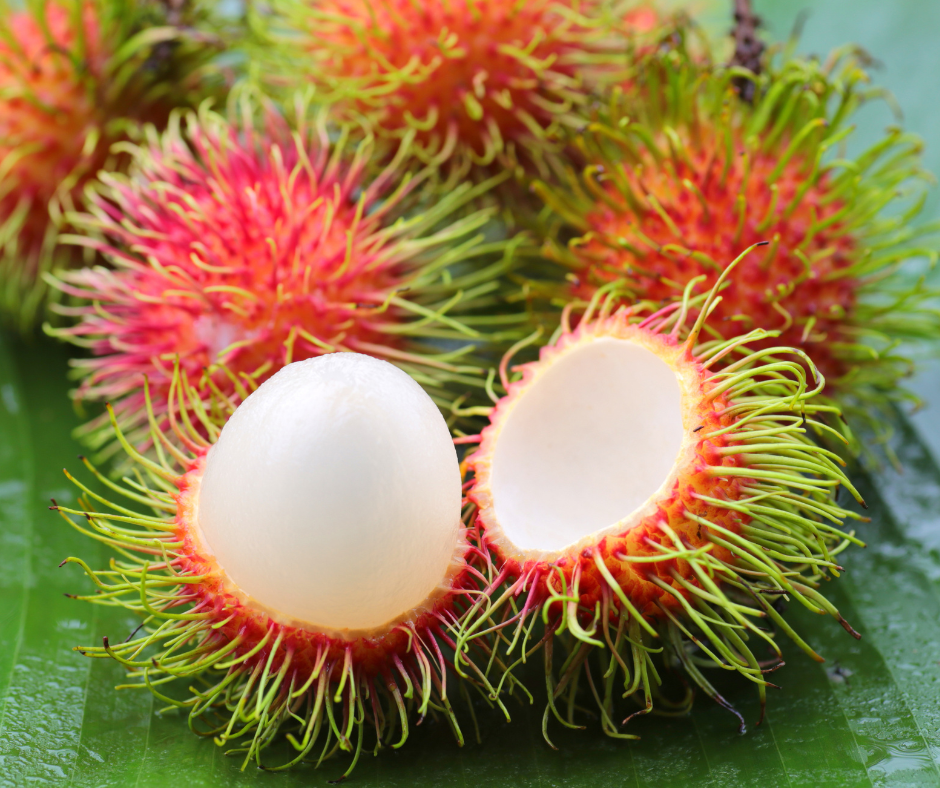Introduction
Thailand is a country famous for its diversity in cuisine, and one of the main aspects that make it unique is its produce, especially in the fruit department. Thailand has many exotic and delicious fruits that many people have never tried or even heard of. This article will explore more about these fruits, including the Red Fruit with Hairs.
Getting To Know Thai Exotic Fruits
When it comes to the fruits in Thailand, many are worth exploring. Some of the most exotic ones include:
- Rambutan: This fruit is famous for its hairy exterior and is usually eaten during its peak season in May.
- Rose Apple: The Rose Apple is a delightful and unique fruit native to Thailand. It captures the essence of Thailand’s tropical bounty.
- Dragon Fruit: With its bright pink skin and white flesh, Dragon Fruit is a feast for the eyes and is now enjoyed all over the world.
- Durian: Widely known as the “King of Fruits,” this fruit has a strong and pungent odor, and its taste is acquired. Despite the dividing opinions, it remains an iconic Thai fruit.
The History And Significance Of Thai Fruits In The Local Culture
The abundance of fruits in Thailand comes from years of agricultural knowledge passed down from generation to generation. The Thais perfected the fruits by experimenting with different growing methods and selective breeding, resulting in local fruit varieties.
The seasons in Thailand also play a significant role in the availability of the fruits. Many Thais will tell you that fruits are seasonal and are influenced by the monsoon.
Lastly, fruits have become an essential and inseparable aspect of Thai culture. They are a symbol of the country’s diversity, and they represent the country’s soil, climate, and people.
In conclusion, Thailand’s exotic fruits are a must-try for any food lover and are integral to the country’s culture and heritage.
Rambutan
Rambutan: The Red Fruit with Hairs
Thailand’s diverse range of fruits is one of the reasons why it attracts tourists from all over the world, and rambutan is one of its most exotic fruits. This fruit is famous as the Red Fruit with Hairs, which is why it’s called rambutan, meaning ‘hairy’ in Malay. It belongs to the family of Sapindaceae and is usually eaten during its peak season in May.
Origin And Peculiarities Of Rambutan
The origins of this Red Fruit with Hairs are deeply rooted in the tropical regions of Southeast Asia, particularly in Indonesia, Malaysia, and the Philippines. The fruit grows in clusters on evergreen trees and is believed to have been cultivated in these regions for centuries. It is known for its juicy and sweet flesh, which encapsulates the essence of Thailand’s tropical bounty.
Rambutan has a unique appearance: a hairy and vibrant red exterior that catches anyone’s attention. Its peculiar exterior is because of the numerous spines or hair-like bumps that cover the fruit. Even after the fruit is removed, its spines leave impressions on it, illustrating its peculiar appearance.
In conclusion, with its roots in Southeast Asia, rambutan has become an essential and inseparable aspect of Thailand’s fruit culture and heritage. Its unique appearance and delicious taste make it a must-try for any food lover visiting Thailand.
Durian
Durian: The King Of Tropical Fruits
Durian, also known as the “King of Fruits,” is a tropical fruit native to Southeast Asia. Its unique flavor and texture have made it a favorite among fruit lovers and have contributed to its popularity worldwide. Durian has a long and fascinating history, believed to have originated from Borneo.
The large fruit has a green, spiky exterior covering its creamy yellow flesh. Its flavor is sweet and savory, with an intense aroma that consumers either love or despise. Depending on one’s taste preferences, it can be consumed raw or used in various dishes, such as ice cream and cakes, and even as a filling for savory dishes.
The Controversy Surrounding Durian’s Aroma
While durian’s unique flavor is appreciated by many, its pungent odor is a controversial topic. In 2018, a German post office was reportedly evacuated due to the smell of the fruit, causing international headlines. Despite its strong aroma, durian is still widely loved and consumed in tropical regions, with many viewing its aroma as a part of its unique character.
In conclusion, durian is a tropical fruit with a distinctive flavor and texture that has earned it the title of the “King of Fruits.” While its aroma may be divisive, its popularity continues to grow globally.
Dragon Fruit
Dragon Fruit: A Fruit Of Beauty
Dragon fruit, also known as Pitaya, is a stunningly beautiful tropical fruit from several cactus species. The fruit has a vibrant pink or yellow exterior with green flaps, and its edible white or reddish flesh is dotted with tiny black seeds.
This exotic fruit is native to Central and South America and is now widely grown in tropical regions such as Southeast Asia, Mexico, and Australia. It is known as “Gao Mung Gorn,” a popular treat that greets visitors on street corners in Thailand.
The Benefits Of Including Dragon Fruits In Your Diet
Dragon fruits are not only visually appealing but also packed with nutrients that offer various health benefits. Here are a few reasons why you should consider including dragon fruits in your diet:
- Low calories: Dragon fruit is mainly water, making it a low-calorie fruit. A 100-gram serving of dragon fruit contains only 60 calories, making it an ideal snack for people watching their weight.
- High in fiber: Dragon fruit is an excellent source of dietary fiber, which promotes digestion and helps maintain healthy bowel movements.
- Rich in antioxidants: Dragon fruit is loaded with antioxidants, which help protect the body from harmful free radicals.
- Boosts immunity: Dragon fruit is rich in vitamin C, which boosts the immune system by stimulating the production of white blood cells.
- Helps regulate blood sugar levels: The fiber and antioxidants in dragon fruit can help regulate blood sugar levels, making it a suitable fruit for people with diabetes.
In conclusion, dragon fruit is not only a stunningly beautiful fruit but is also packed with essential nutrients that offer numerous health benefits. Incorporating this tasty and nutritious fruit into your diet will boost your health and add some delightful color to your plate.
Mangosteen
Mangosteen: The Queen Of Fruits
Mangosteen, scientifically known as Garcinia mangostana Linn., is a celebrated tropical fruit in Thailand, often hailed as the Queen of Fruits due to its exquisite taste and stunning appearance. Its deep purple leathery rind encases a delicate balance of sweet and tangy flavors, making it stand out from other fruits. Mangosteen is mainly planted in rural provinces of Thailand, and each tree can live up to 100 years, making it a precious and rare find.
Mangosteen Nutritional Value And Health Benefits
Besides its unique taste and appearance, mangosteen is packed with essential nutrients that offer various health benefits. It is loaded with antioxidants that help protect the body from harmful free radicals. Additionally, it’s rich in fiber, which promotes digestion and helps maintain healthy bowel movements. Here are a few more reasons why you should consider adding mangosteen to your diet:
- Boosts immunity: Mangosteen contains vitamin C, which can stimulate the production of white blood cells, boosting the immune system.
- Helps regulate blood sugar levels: The fiber and antioxidants in mangosteen can help regulate blood sugar levels, making it a suitable fruit for people with diabetes.
- Reduces inflammation: Mangosteen has anti-inflammatory properties that can help relieve inflammation.
- May protect against cancer: The xanthones present in mangosteen have been shown to have anti-cancer properties in some studies.
In conclusion, mangosteen is an underrated fruit that deserves more attention due to its unique taste and numerous health benefits. Incorporating it into your diet can add a burst of flavor and provide essential nutrients that can improve your overall health.
Longan
Longan: The Little Brother Of Lychee
Longan is a small fruit that belongs to the same family as lychee and rambutan. It has a sweet and floral flavor similar to grapes but more exotic. Longan is mainly grown in the Northern provinces of Thailand, such as Lamphun, Chiang Mai, and Chiang Rai. Its peak season in Thailand is from June to August, costing approximately 30 THB per kilogram.
Longan has a unique taste and texture, making it stand out from other fruits. Its flesh is translucent and juicy, with a seed in the middle. When ripe, the fruit’s skin turns brown and hard, making it easy to open.
Longan is rich in vitamins and minerals that offer various health benefits. It contains vitamin C, which supports the immune system and helps fight diseases. It also has potassium, magnesium, and calcium, contributing to healthy bone and muscle function.
The Versatility Of Longan In Thai Cuisine
Longan is a versatile fruit that is used in many Thai dishes. It is commonly added to desserts, such as sticky rice with mango or coconut milk. It is also used in savory dishes, such as stir-fries, curries, and salads. Longan’s sweetness pairs well with spicy and savory flavors, making it a popular ingredient in Thai cuisine.
In conclusion, longan is a delicious and nutritious fruit often overshadowed by its more popular siblings, lychee and rambutan. Its unique taste and versatility make it an essential ingredient in Thai cuisine. Incorporating longan into your diet can add a burst of flavor and provide essential nutrients that can improve your overall health.
Jackfruit
Jackfruit: The Largest Tree-borne Fruit
Jackfruit, also known as Khanoon in Thailand, is the largest tree fruit in the world, with some fruits reaching a weight of up to 55kg. It is the fruit of the jack tree, which is a species of tree in the fig, mulberry, and breadfruit family. The tree is native to Southeast Asia but is now grown in many parts of the world, including Thailand, India, and Brazil. A mature jackfruit tree can produce up to 200 fruits annually, with some older trees bearing up to 500 fruits annually. In Thailand, the fruit is available between January and May.
Exploring The Texture And Flavor Of Jackfruit
The jackfruit has a distinctive aroma and succulent taste when ripe. Its texture is meaty and fibrous, with a chewy bite. The fruit’s flesh is yellow or orange and is also used as a meat substitute for vegetarians and vegans due to its texture.
Jackfruit has a unique flavor that can be difficult to describe. Some people compare it to a combination of pineapple, mango, and banana. The unripe jackfruit has a mild flavor and can be used as a vegetable in many dishes. It has a neutral flavor and soaks up the flavors of the spices and sauces it is cooked with.
In Thailand, jackfruit is commonly used in desserts such as “kanom chun” and “kanom mai orn.” It is also used in savory dishes such as “gang kari” and “yum kanoon.” In some parts of the world, it makes jams and chutneys.
Overall, jackfruit is an incredibly versatile fruit that is used in a variety of dishes around the world. Understanding its unique texture and flavor allows for greater appreciation of this exotic fruit.
Lychee
Lychee: The Sweet Jewel Of Thailand
Lychee, also known as “linchi” in Thailand, is a small and delicate fruit covered with a red, roughly-textured rind that is inedible but easily removed to reveal a layer of sweet, translucent white flesh. Like many other exotic fruits, lychee greets visitors on almost every corner of Thailand, thanks to the country’s fertile plains and hot tropical climate, as well as its more temperate northern regions that allow for a plentiful supply of gorgeous and tasty fruit.
Lychee is hailed as a prized fruit in Thailand due to its unique taste and texture that combines sweetness, juiciness, and a hint of floral aroma. The fruit is widely consumed fresh but is also processed into juice, candies, and other desserts. In Thailand, lychee is in season from late May to July.
The Cultural And Culinary Significance Of Lychee
Lychee holds significant cultural and culinary importance in Thailand. The fruit is often offered during important festivals and ceremonies, such as the Chinese New Year and the Songkran Water Festival. Moreover, lychee is a symbol of love and romance in Thai culture and is often used as a gift to express affection.
Regarding culinary applications, lychee is a popular ingredient in many Thai dishes, ranging from savory curries, stir-fries, and salads to sweet desserts. For example, it is used in the famous “tub tim krob,” a traditional Thai dessert made with a combination of water chestnuts, jackfruit seeds, and lychee in sweetened coconut milk. In addition, lychee pairs well with other tropical fruits such as mango, banana, and passionfruit.
Overall, lychee showcases cultural and culinary significance in Thailand and is a must-try fruit for anyone visiting the country.
Conclusion
In Thailand, one can find a fascinating variety of fruits not commonly found in other parts of the world. One such fruit is the red fruit with hairs, also known as the rambutan. This small, round fruit is covered in soft, red, spiky hairs that give it a unique appearance. But don’t let its appearance deceive you; it is sweet and juicy inside.
The texture of the fruit is similar to lychee, with translucent white flesh and a hard seed in the center. The rambutan is delicious and packed with health benefits, such as being a good source of vitamin C, iron, and fiber. So, if you ever find yourself in Thailand, be sure to give this exotic fruit a try!
Summing Up The Unique And Diverse Fruits Of Thailand
Thailand is home to one of the world’s biggest and most diverse collections of tropical fruits. Some must-try fruits include the famous stinky fruit of Thailand (Durian), mangosteen, snake fruit, and rambutan. Each fruit offers a unique flavor profile and cultural significance that showcases Thailand’s rich culture and culinary prowess.
Suggestions For Trying Out These Exotic Fruits On Your Next Trip To Thailand.
In Thailand, one should not miss the opportunity to indulge in the tropical fruits. Here are some suggestions for trying them out:
- Visit local markets and street vendors to sample freshly cut fruits.
- Visit fruit orchards and farms to learn about fruit production and sample the fruits.
- Try exotic fruit-based delicacies such as ice cream, smoothies, and desserts.
- Experiment with pairing the fruits with local cuisine and popular Thai flavors such as coconut milk and chili.
In conclusion, Thai fruits offer a delicious and unique experience that should not be missed by anyone visiting the country. It is one of the best reasons to visit Thailand and a must-try for all fruit enthusiasts.
FAQ
Q: What is the red fruit with hairs that is mentioned in the online data?
A: The fruit is called rambutan, scientifically known as Nephelium lappaceum. It has a hairy red exterior but inside it is a succulent sweet fruit that is rich in vitamin C.
Q: How does rambutan taste like?
A: The taste of rambutan is sometimes compared to grapes, and the flesh of the fruit is translucent white or pink, depending on the variety.
Q: Is rambutan commonly found in Thailand?
A: Yes, rambutan is a famous tropical fruit in Thailand. In fact, the fruit is known as “ngaw” in the Thai language, and the rambutan season in Thailand runs from June/July to September.
Q: What is the price range of rambutan in Thailand?
A: The price of rambutan in Thailand is around 30 to 40 Baht for a one-kilo bag of fruit from street vendors.
Q: Why is rambutan called rambutan?
A: The word rambutan comes from the Malay/Indonesian word ‘rambut,’ which means ‘hair,” referring to its hairy red exterior.



